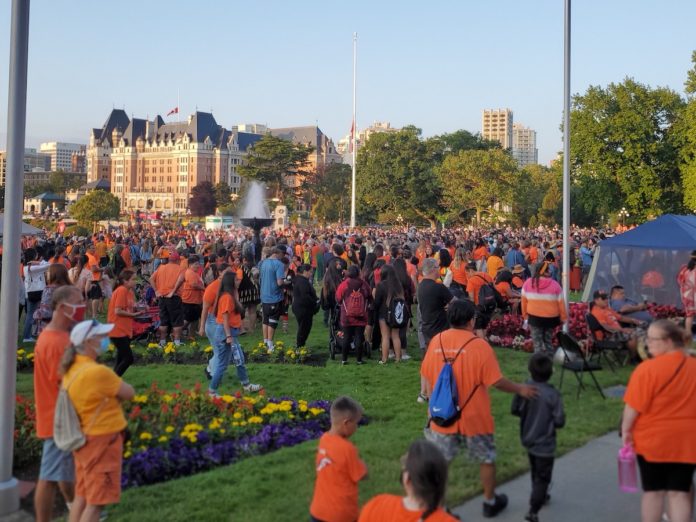
WARNING: This article contains potentially distressing subjects such as residential schools and resulting deaths. Those seeking emotional support and crisis referral services can call the 24-hour National Indian Residential School Crisis Line: 1-866-925-4419.
Within B.C, S.A.F.E.R. focuses on preventing suicide and providing help to those who lost a loved one to suicide. Call 604-675-3985 from 9 a.m. to 5 p.m. Monday to Friday to get help accessing grief counselling.
About 4,000 people gathered outside the Legislative Assembly of British Columbia on Thursday to honour Indigenous children, including those that lost their lives at residential schools.
The event also celebrated the Lekwungen people’s identity, who come from Songhees, Esquimalt and W̱SÁNEĆ Nations. Victoria, B.C., where the event took place, is on their unceded land. The gathering was planned with the permission of Hereditary Chief Seenupin Edward Thomas of Esquimalt.
The gathering occurred following the discovery of hundreds of bodies of Indigenous children who were found in unmarked burial sites at residential schools in British Columbia and Saskatchewan. Most protesters wore orange, a shirt colour that was adopted to commemorate the lives lost to residential schools.
First Nations are in the process of verifying the exact number of unmarked graves of children. The federal government has pledged $27 million to finance these investigations.
The gathering also occurred on Canada Day amid growing calls from Indigenous groups to reflect and mourn the children who never returned home from residential schools.

Attendees first participated in a moment of silence, followed by a thank you to residential school survivors for keeping the Lekwungen Nations alive.
Jerry Edward, a First Nations man, said he tries not to get too emotional about his residential school grief.
Edward said his parents attended the Kuper Island Indian Residential School on Kuper Island, B.C. in the early 1940s. He said he felt a great loss by the outlawing of his cultural dance until the 1960s, adding that his mother’s time at a residential school meant he was never initiated into the cultural dances which occur in private and are passed on maternally.
He said answers on what happened to Indigenous children who attended residential schools in Canada will take time, but “these things will need to come out.”
Close to the end of the gathering, speaker Kati George-Jim took the microphone. Her parents come from Tseycum First Nation and T’Sou-ke First Nation.
“[I am here] because of these people who keep our songs alive, our names alive, keep our children, elders, women and queer people alive,” George-Jim said.
“Ninety-nine per cent of our people have been killed in genocide,” George-Jim said. “Those of us who have survived today, we are the victors … So, I love you. I love you so much it brings tears.”
George-Jim then asked attendees to join in on the Women’s Warrior Song while she led a slow walk down Government Street. The song pays tribute to missing and murdered Indigenous women, girls and two-spirited people and asks the listener to recognize the strength of women’s spirits.
When the crowd encountered the statue of Capt. James Cook, an 18th-century British explorer and settler, about 200 people surrounded the base of the statue while wooden cut-outs of red dresses were placed upon it.
Around 8:30 p.m., the Captain Cook statue was torn down and thrown into Victoria’s Inner Harbour.
“You are seeing history today,” George-Jim said as the statue landed in the harbour. “Nobody can take our birthright away to be Indigenous.”

The toppling of the Cook statue echoed recent events in Winnipeg, where protestors tore down statues of Queen Victoria and Queen Elizabeth II at similar events which rallied support for Indigenous communities on July 1.
As the crowd left the Legislative Assembly, Marlene Mickey, a First Nations woman, remained beside the memorial. Mickey said her mother is a residential school survivor.
“I’m actually happy for us. [The gathering] brought out a lot for us and for my mother,” Mickey said.
Tiffany Joseph, a First Nations woman who organized the event, said she was grateful to the hosts of the territory for letting the event go forward. Joseph also said that the high turnout was “beautiful.”
“I really loved seeing the sea of orange shirts here, people celebrating our language and culture,” Joseph said. “It was a really good event and I hope it filled up the souls of the thousands of attendees today.”
Featured photo by Morgana Adby.





